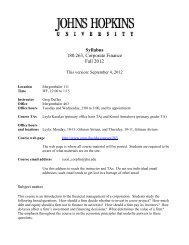Packet - Economics - Johns Hopkins University
Packet - Economics - Johns Hopkins University
Packet - Economics - Johns Hopkins University
You also want an ePaper? Increase the reach of your titles
YUMPU automatically turns print PDFs into web optimized ePapers that Google loves.
Essays on Mergers, Collusion, and Innovation<br />
Wei Zhao<br />
1 Estimating Dynamic Merger Efficiencies with an Application to the<br />
1997 Boeing-McDonnell Douglas Merger (job market paper)<br />
This paper evaluates the welfare effects of the 1997 merger between Boeing and McDonnell<br />
Douglas in the medium-sized wide-bodied aircraft industry. I develop an empirical model<br />
of multi-product firms, allowing for both learning-by-doing and product innovation in the<br />
dynamicgametoquantifymergerefficiency. Mergerefficiencyfromlearning-by-doingisthen<br />
disentangled from impact of innovation and market power effect. The results show that the<br />
primary benefits from the 1997 Boeing-McDonnell Douglas merger come from accelerated<br />
learning-by-doing. Taking account of all static and dynamic effects, net consumer surplus<br />
is found to have increased by as much as $1.57 billion. In contrast, a static model ignoring<br />
dynamic learning-by-doing and innovation predicts a consumer loss of about $20 billion.<br />
These results show that ignoring dynamic effects can lead to biased results and erroneous<br />
conclusions with regard to the welfare impact of a merger.<br />
2 Signaling and Tacit Collusion in an Infinitely Repeated Prisoners’<br />
Dilemma (with Joseph E. Harrington, Jr.), Mathematical Social Sciences,<br />
64(2012) 277-289<br />
In the context of an infinitely repeated Prisoners’ Dilemma, we explore how cooperation is<br />
initiated when players signal and coordinate through their actions. There are two types of<br />
players - patient and impatient - and a player’s type is private information. An impatient<br />
type is incapable of cooperative play, while if both players are patient types - and this is<br />
common knowledge - then they can cooperate with a grim trigger strategy. We find that the<br />
longer that players have gone without cooperating, the lower is the probability that they’ll<br />
cooperate in the next period. While the probability of cooperation emerging is always<br />
positive, there is a positive probability that cooperation never occurs.<br />
3 Vertical Relation and Endogenous Innovation in a Dynamic Stochastic<br />
Game (in progress)<br />
Motivated by firms expanding to adjacent vertically related markets as has recently occurred<br />
in the markets for smartphone and tablets, I develop an infinite-horizon dynamic<br />
stochastic model to analyze the relationship between innovation and vertical structure in<br />
high-technology industries. The stochastic model serves to examine dynamic interactions<br />
of firm innovation and imitation. In this model, upstream firms decide on investment for<br />
innovation and the degree of compatibility, while downstream firms dynamically choose<br />
their technology suppliers based on realized switching cost. Bargaining power between the<br />
upstream and downstream firms is modeled as a division of the downstream profit. Vertical<br />
integration removes uncertainty about downstream firm commitment for the innovators,<br />
but is also likely to decrease imitation and compatibility as well as encourage downstream<br />
firms to switch (which may facilitate upstream entry). The model provides a framework<br />
for empirical dynamic studies and can be used to analyze the impact of vertical structure,<br />
bargaining power and switching costs on innovation and consumer welfare.




